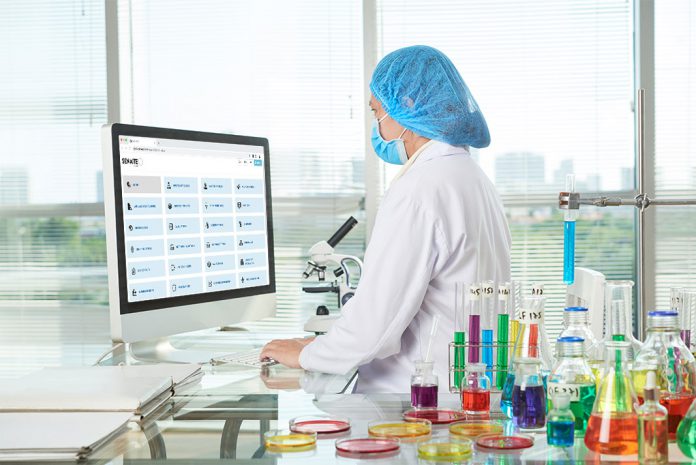Are you thinking of buying a laboratory information management system (LIMS) for your clinical laboratory in a hospital or even a private lab?. If you, so you have come to the right place as we are here to help you choose the right LIMS / LIS that fits your facility needs.
There is no doubt that LIMS has become one of the essential technologies in every facility seeking better workflow management and adding other services that you have never provided to your patients.
Before starting the buying process, you have to do good research in your country for companies which provide such services.
Define your objectives
you should count what you need to do, building the workflow in mind is better than watching what is provided in the market, you might miss some important features in the purchased solution and other times you might over buy features not essential to your objectives.
Defining your objectives of buying a LIMS will make it clear what features you need, below you will find examples for the potential objectives you have to think about when buying LIMS.
- Workflow management
- Increased productivity and efficiency
- working on quality projects (QA/QC)
- Accreditaions
- Monitoring & Analytics
Single facility or multiple branches
The type of your facility will help in choosing the relevant technology to use and the typical vendors to deal with based on your project scope. As an example, Buying LIMS solution for several branches of laboratories you want to automate and interconnect, it would be better to use a centralized solution with a single database than using decentralized ones, buying a LIMS for a single branch might be simpler or cheaper and even you can go to a cloud solution or SAAS solution or both.
Involve key stakeholders in the buying decision
People who will work and maintain the LIMS environment up and running should participate and share their opinion regarding choosing what suits their needs and plans, IT management should listen to the different kinds of technologies or IT infrastructure requirements and choose the better to the current situation. Lab doctors should attend a demonstration and watch if the solution workflow fulfills their requirements and check the important features for them.
Arrange your priorities
Most of us think that buying more features is better for me, I think this is not working the way you imagine. if you are on a budget you will not have the facility to buy LIMS with bells and whistles, but you will have to compromise your package to your essential needs only, you can plan for the total package on the long run.
The company first
Buying a LIMS is not just about buying a product for one time, but it’s a long term relationship between you and the company that provides you with the solution and after sales services, as the true value of a LIMS solution lies within the quality of services you get after buying, you should seek a reputable company that has a proven track record or a good reputation in the market, you can ask them for references and make audit calls or site visits.
The response time of the company about your inquiries and ease to reach them is one of the indicators of their attitude if you have become a customer, if a company always delays in contacting you and answering your questions or fulfill your requirements, it would be a bad indicator to what might happen after you become their client.
Ask the company to present some documents like company profile, reference sites list, product catalogs and you can also refer to their website if needed.
you might ask for a live demonstration and a discussion regarding their solution and how it can fulfill your needs, asking an important question about their competitive edge over other solutions and try to write down your notes which will help you in making a good comparison among different vendors.
Purchase or rent LIS/LIMS
When it comes to choosing the right laboratory information management system (LIMS) for your needs, one important decision is whether to purchase or rent the software. There are pros and cons to both options, and the choice will depend on factors such as your budget, long-term goals, and specific requirements.
Purchasing a LIMS gives you ownership of the software and allows for more customization and control. It may be a good option if you have specific needs that require extensive customization or if you plan to use the system for a long period of time. However, purchasing a LIMS can be a significant financial investment, and you will be responsible for maintenance, upgrades, and ongoing support.
On the other hand, renting a LIMS offers flexibility and a lower upfront cost. This option is ideal if you have a limited budget or if you only need the software for a short period of time. Renting a LIMS also provides access to support and regular updates from the vendor. However, you may have limited customization options and may not have ultimate control over the system.
Ultimately, the decision between purchasing or renting a LIMS will depend on your specific needs and circumstances. Consider factors such as budget, long-term goals, customization requirements, and maintenance and support needs to make the best choice for your laboratory.
Install on premises or getting software as a service
When it comes to choosing the right Laboratory Information Management System (LIMS), one important consideration is whether to install it on premises or opt for software as a service (SaaS).
Installing LIMS on premises means that the software is installed and managed on your organization’s own servers and infrastructure. This option provides more control and customization but requires dedicated IT resources and maintenance.
On the other hand, getting LIMS as a service means that the software is hosted and managed by a third-party provider. This option offers greater flexibility, scalability, and accessibility as it can be accessed from any device with an internet connection. Additionally, it eliminates the need for extensive IT infrastructure and ongoing maintenance.
Choosing between the two options depends on your organization’s specific needs, resources, and security requirements. It is important to carefully evaluate the pros and cons of each approach to make an informed decision that best suits your laboratory’s needs.
Web-based or desktop application
Web-based solutions have been famous in the last years and now you can find many technology developers providing this kind of technology, but this didn’t dominate the desktop based applications till now, there is still vendors that provide desktop applications with large market shares in LIMS market, it all depends on what’s more relevant to you.
Desktop based LIMS is licensed for each computer you will use to operate the system, that means that you cannot run the software without installing a license on the terminal to be used, so you can use LIMS through specific points only but there is no other option to access from any other device without licenses.
Also, there are limitations in usage of the system on multiple devices, you might run only on PC without ability to operate from tablet or smartphone. That makes us think about the ability to run the software over different operating systems like windows, Mac, Linux, …etc. as companies don’t have the ability to run on all platforms.
On the opposite, web-based LIMS has some advantages over desktop based LIMS that can be summarized in the following points:
- Accessibility anywhere, you can access your profile from any device even if it’s not associated with your facility, you can open it from home or even while travelling to watch what’s going on.
- Accessibility on any device, using browser based software will give you the advantage to use your software on any device including pc, laptop, tablet or smartphones.
- Accessibility on any operating system, browser based LIMS gives you the facility to use the operating system you are used to for every user, each user has the option to operate from a different operating system and it’s not mandatory anymore to use just Microsoft windows, it’s now supporting mac, android, ios, linux,…etc.
Support & maintenance contracts
One of the most important criteria to make your decision about a LIMS is the quality of support services provided by the vendor, you might find some vendors provide onsite support if they are in your local market, most LIMS vendors provide remote support and online chatting services.
Response time is one of the key metrics in support services, number of hours per day supported and number of days a week supported, if they provide online support service through their website, you can test this service and it will be a fair indicator to know how fast they are in responding to your inquiries.
After sales service is not less important than the lab management software itself, it might even be more important, as you are running a healthcare facility so you want to guarantee your workflow to be up and running all of the time with minimal breakdowns, that’s why it’s important to ask about the vendor’s policy in service contracts and how much it costs to e considered in your annual budget.
Interoperability with other systems
If you are intending to buy a LIMS, you should ask yourself an important question, is it a standalone solution or it will be integrated with other systems.
If you are running a private laboratory even single or multiple facility, you might need to integrate LIMS with other solutions like ERP to exchange financial data about the daily operations, it might be a LIMS inside a hospital that has hospital information management system and they should be integrated together to unify the medical record of patients. You should ask your vendor about supporting such services and which integration standards they use in their integration protocols, it should match the protocols used by other systems’ vendors to guarantee seamless and fast integration among your IT ecosystem.
Instrument integration
When considering a laboratory information management system (LIMS) for your facility, one important factor to take into account is instrument integration. Integration with laboratory instruments can greatly enhance the efficiency and accuracy of your lab processes.
A good LIMS should have the capability to seamlessly integrate with a wide range of instruments used in your laboratory, such as analyzers, spectrophotometers, and chromatography systems. This integration allows for direct transfer of data from the instruments to the LIMS, reducing the need for manual data entry and minimizing the risk of errors.
When evaluating LIMS vendors, inquire about their experience with instrument integration and their ability to integrate with the specific instruments you use in your lab. Ask for demonstrations or case studies to see how the LIMS handles instrument integration and how it can streamline your workflow.
Choosing a LIMS that offers robust instrument integration can significantly improve the efficiency and accuracy of your laboratory processes, saving time and resources while ensuring reliable results.
Licensing and cost
LIMS vendors might provide versatile business models that depends on multiple variables like vendor marketing strategy, technology or market related variables. You can find multiple options for license which consequently affects solution cost, you should choose what would be more feasible and cost efficient on the long term to achieve a good return on investment when applying such solution.
The common pricing criteria in the market can be summarized as following:
- Named users. (number of created usernames)
- Concurrent users. (number of users who are online at the same time)
- Patient visits rate. (number of patients registered visits per year)
- Number of transactions.
- Extra modules.
- Instrument interfacing.
- Integration cost with other solutions.
- Data migration from old to new solution.
Is it easy to use?
One of the challenges you might face while applying a new LIMS or even replacing an existing one, is the change to a new workflow and system that might not be user friendly to its operators, you should look for an easy to use platform to guarantee less challenges in adoption by its users.
Well arranged and organized user interface will help user to digest more quickly with less errors or breakdowns along the way, intuitive interface would shorten the frequency of trainings of even the length of training sessions.
Systems that can be personalized for each user is more appealing and efficient in giving the option for everyone to personalize their own accounts in the way that makes them work better.
Bargaining power
Competitive markets that have multiple vendors providing competing technology and prices might work for your sake, you can negotiate for the best deal if you have this facility, if you don’t have local vendors you might go for international providers and this might cost you more than expected as long as only few companies has the ability to reach and penetrate international markets with the ability to support a large base of clients around multiple countries.
You can choose the vendor who will give you what you need at the cost that you are able to pay with relevant facilities and support. That doesn’t mean that cheaper is better, but it means that you will choose what is more relevant to your objectives as I mentioned before.
Conclusion
Finding the right LIMS for your laboratory is a critical decision that impacts your day-to-day operations. By considering functionality, scalability, and user-friendliness, you’ll be well on your way to selecting a system that fits your needs perfectly. Invest time in researching different options, gathering feedback from users, and conducting demos to ensure a successful implementation. Your laboratory’s efficiency and effectiveness will depend on the LIMS you choose, so choose wisely.
Read Also
- How to Drive Growth Through Customer Centricity in HealthcareThe world of healthcare is changing in big ways. Consumers are now stepping up and taking charge of their health journeys. This change is happening now for important reasons. The U.S. health and wellness market is huge, projected to be over $6 trillion in 2025. This growth is fueled by rising out-of-pocket costs and more… Read more: How to Drive Growth Through Customer Centricity in Healthcare
- Maximizing Digital Reach for Podiatry Clinics in Local HealthcareMaximizing Digital Reach for Podiatry Clinics in Local Healthcare As the healthcare industry evolves, mobile marketing becomes indispensable for practitioners. Podiatry clinics, focusing on foot and ankle care, must adapt to digital strategies to engage patients effectively. Implementing tailored SEO practices is crucial for these clinics to thrive in an increasingly competitive market. Digital marketing… Read more: Maximizing Digital Reach for Podiatry Clinics in Local Healthcare
- Leveraging Virtual Medical Assistants to Maximize Operational Efficiency in HealthcareIn the increasingly complex and fast-paced world of healthcare, operational efficiency is critical. Doctors and healthcare administrators are faced with numerous challenges, from managing patient scheduling and medical billing to adhering to stringent regulatory compliance and insurance claims processing. These tasks, while essential, often divert time and resources away from the core mission of providing… Read more: Leveraging Virtual Medical Assistants to Maximize Operational Efficiency in Healthcare
- Optimizing CT Protocols: The Hidden Key to Efficiency and Cost Savings in RadiologyIntroduction: Why CT Protocol Optimization Matters Computed Tomography (CT) is a cornerstone of modern diagnostic imaging, providing critical information across nearly every medical specialty. However, maximizing the value of CT — both clinically and financially — requires more than just advanced hardware. The real secret lies in the optimization of CT protocols. When CT protocols… Read more: Optimizing CT Protocols: The Hidden Key to Efficiency and Cost Savings in Radiology
- Hospital Discharge Accuracy Improves With Daily Advisor InvolvementThe hospital discharge process has a big effect on patient recovery, hospital efficiency, and finances. It requires careful planning and clear communication between team members to make sure patients get the right care when they leave the hospital. Having physician advisors involved at this stage can improve the discharge process by spotting problems that need… Read more: Hospital Discharge Accuracy Improves With Daily Advisor Involvement
- Understanding Clinical Trials: What to Learn and the RoadblocksClinical trials are research studies conducted to determine the efficacy of medical, surgical or behavioral interventions. They are the most commonly used way that researchers assess whether new treatments, drugs or medical devices are safe and effective for use in humans. There are strict protocols governing these studies, and all of this is done in such a… Read more: Understanding Clinical Trials: What to Learn and the Roadblocks
- The Patient’s Voice: 7 Ways to Improve TelehealthTelehealth has transformed how we access healthcare, making it more convenient and accessible than ever before. However, as this technology evolves, so does the need for improvement. Patient feedback is essential in shaping these telehealth experiences. It offers valuable insights into what works, what doesn’t, and how we can make virtual care even better. Currently,… Read more: The Patient’s Voice: 7 Ways to Improve Telehealth
- The Role of Carbide Burs in Modern Dental ProceduresAs a result of this procedures need to be well coordinated and to this end, precision tools are used by dental practitioners. Among the most essential tools in a dentist’s arsenal are carbide burs, which have revolutionized various aspects of dental work. Today’s dentistry cannot work without these tools as they are both strong, sharp,… Read more: The Role of Carbide Burs in Modern Dental Procedures









